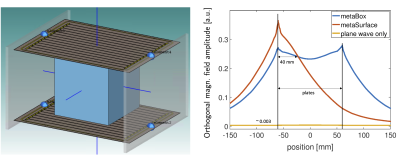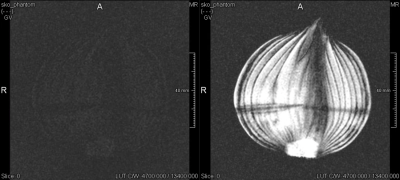2177
Smart MetaBox: Metamaterial arrangement for volume-homogeneous SNR enhancement1Fraunhofer MEVIS, Bremen, Germany, 2University of Bremen, Bremen, Germany, 3Fraunhofer FHR, Wachtberg, Germany, 4DKFZ, Heidelberg, Germany
Synopsis
A metamaterial arrangement that encloses a volume "metaBox" is shown to yield a significant and volume-homogeneous SNR enhancement in 3T MRI. Due to the integration of non-linear components, the structure self-detunes in Tx whilst being resonant in Rx. Fine-tuning capabilities are included in two different prototypes via (i) a manually trimmable capacitor and (ii) a Bluetooth-controlled digital capacitor that allows for a wireless interface. On-bench characterization as well as MRI experiments verify the functionality of the device. Thus, the metaBox is ideally suited for, e.g., imaging of extremities.
Introduction
Physiological and technological restrictions are limiting physically feasible improvements in the field of MRI. There are, e.g., higher static fields needed for signal-to-noise ratio (SNR) improvement and gradient field switching times limit imaging speed. Both aspects come with subtle challenges making it increasingly challenging to innovate. Metamaterial (MTM) technology[4,5] offers promising solutions to advance the efficiency, yielding sensitivity and speed improvements.[1-3],[6-10] Thin (sub-mm) MTMs have been shown to locally boost the SNR up to an eightfold improvement,[1] overcoming bulky structures as presented in the literature[2-3],[9-10] to allow for more applications. This SNR enhancement, however, is a local effect that decreases with distance, thus, limiting the ROI. The goal is to design MTMs, which i) are smart, i.e., do not influence the excitation by self-detuning in Tx and ensure patient & electronics safety, and ii) lead to a homogeneous SNR enhancement in a volume of interest. Coupled non-linear metamaterial structures fulfill these requirements.Methods
We show that the combination of multiple MTM structures, which enclose a volume (approx. 20 x 15 x 10 cm3), leads to a homogeneous SNR enhancement. We employ the design of metasurfaces – two-dimensional MTMs – which are manufactured on a single 0.508 mm thin PCB (RO4003C, 17.5 μm-thick Copper layers) and consist of two inductively coupled structures: 1) a linear metasurface build of flat wire-resonator unit cells, and 2) a limiting diode-loaded loop[1]. The wire-resonators are strongly coupled and electrically elongated by capacitive end-patches and ground planes (backside) to obtain a resonance frequency at 123.5 MHz. At least two of the metasurfaces are combined to enclose a volume and, thus, form a MTM termed “metaBox”. Close resonant structures couple inductively and the full system shows a splitting of the fundamental mode, which needs to be tuned to the desired resonance. The mode for which the single structures are in phase is chosen. An analytical description via the coupled mode theory is performed together with electromagnetic simulations, which allow to iterate the design. CST Microwave Studio is used for Eigenmode and plane wave simulations. Eigenmode simulations offer an important tool to study the mode’s spatial field distribution and match the resonance to the Larmor frequency of an MRI system. Plane wave simulations with circular polarization and open boundaries allow to include a phantom and simulate loading. The functionality is tested on bench by S-parameter measurements and via MRI experiments. Untuned sniffer coils connected to a vector network analyzer are used to characterize the smart metaBox depending on the incident power. A trimmable capacitor in the non-linear tuning loop is used to fine-tune the resonance. For MRI scans, a gradient echo sequence is used with the following parameters: TR = 100 ms, TE = 5 ms, field-of-view = 96 x 96 mm2, matrix size = 192 x 192. The imaging is done with a 3 T Magnetom Skyra (Siemens Healthineers, Germany) and i) the scanner’s body coil, ii) the body coil + smart metaBox. For all scans, we use the unique, vendor-independent sequence development framework gammaSTAR[11]. In a second prototype, the trimmable capacitor in one of the MTM structures is replaced by a digital one, which is connected via SPI to a Bluetooth-enabled low-power microcontroller. This setup allows to wirelessly tune the metaBox.Results
In Fig. 2, we show the MRI scan of an onion with and without the smart metaBox. In both cases, the scanner’s body coil was used for Tx and Rx. The slice shown in the plot is orthogonal to the two metasurfaces at the top and bottom of the structure. We observe a SNR increase factor of about 9 throughout the slice w.r.t. the body coil alone, without a distance-dependent fall-off.Discussion
On-bench measurements of scattering parameters as functions of the incident power prove the working principle for the manufactured prototype. Below a certain threshold, the smart metaBox is resonant at the design frequency. At higher incident power, the structure detunes due to the non-linear behavior. An analytical study via the coupled mode theory and numerical simulations of the field distribution are in agreement with experimental results. MRI experiments show that the distance-dependent SNR enhancement that is observed for single metasurfaces may be overcome. The metaBox leads to an almost homogeneous enhancement in the entire enclosed volume. Thus, metasurfaces may be considered as MTM analogies to surface coils whereas the metaBox is a MTM generalization of a volume coil. Comparisons to dedicated surface and volume coils are ongoing efforts to characterize the metaBox. As compared to a single metasurface, the metaBox offers a smaller SNR increase very close to either of the two outer MTM layers (top and bottom), see Fig. 1. However, at some distance the metaBox performs better and leads to an almost constant enhancement effect.Conclusion
Being a comparatively young research field, MTMs in MRI have a great potential and are a promising tool to tackle some of the challenges that hamper advancements. They offer to increase the SNR significantly without immediate need of higher field strengths. Patient safety is taken care of by the detuning mechanism, which will be supplemented by SAR simulations. Fine-tuning via wireless communication at low-power puts MTMs to the next level.Acknowledgements
This work was supported by the Fraunhofer MAVO project MetaRF. The authors want to thank Peter Erhard for discussions and comments and Michael Jäger for support in the production of prototypes.References
[1] Stoja, E., Konstandin, S., Philipp et al., “Improving magnetic resonance imaging with smart and thin metasurfaces,” Nature Scientific Reports 11, 16179 (2021) DOI: 10.1038/s41598-021-95420-w
[2] Zhao X, et al. Intelligent metamaterials based on nonlinearity for magnetic resonance imaging. Advanced Materials. 2019, Vol. 31, 1905461.
[3] Saha D, et al. A smart switching system to enable automatic tuning and detuning of metamaterial resonators in MRI scans. Sci Rep. 2020, Vol. 10, 10042.
[4] Vesselago V G The electrodynamics of substances with simultaneously negative values of e and m. Soviet Physics Uspekhi. 1968, Vol. 10, 4.
[5] Pendry J B, Schurig D, Smith D R Controlling electromagnetic fields. Science. 2006, Vol. 312, 5781.
[6] Freire M J, et al. On the applications of m = -1 metamaterial lenses for magnetic resonance imaging. Journal of Magnetic Resonance. 2010, Vol. 203.
[7] Duan G, et al. Boosting magnetic resonance imaging signal-to-noise ratio using magnetic metamaterials. Communications Physics. 2019, Vol. 2, 35.
[8] Slobozhanyuk A P, et al. Enhancement of magnetic resonance imaging with metasurfaces. Adv. Mater. 2016, Vol. 28.
[9] Shchelokova A V, et al. Locally enhanced image quality with tunable hybrid metasurfaces. Phys. Rev. Applied. 2018, Vol. 9, 014020.
[10] Kretov E I, Shchelokova A, Slobozhanyuk A P Control of the magnetic near-field pattern inside MRI machine with tunable metasurface. Appl. Phys. Lett. 2019, Vol. 115, 061604.
[11] FraunhoferMEVIS, gammaSTAR, https://gamma-star.mevis.fraunhofer.de
Figures

